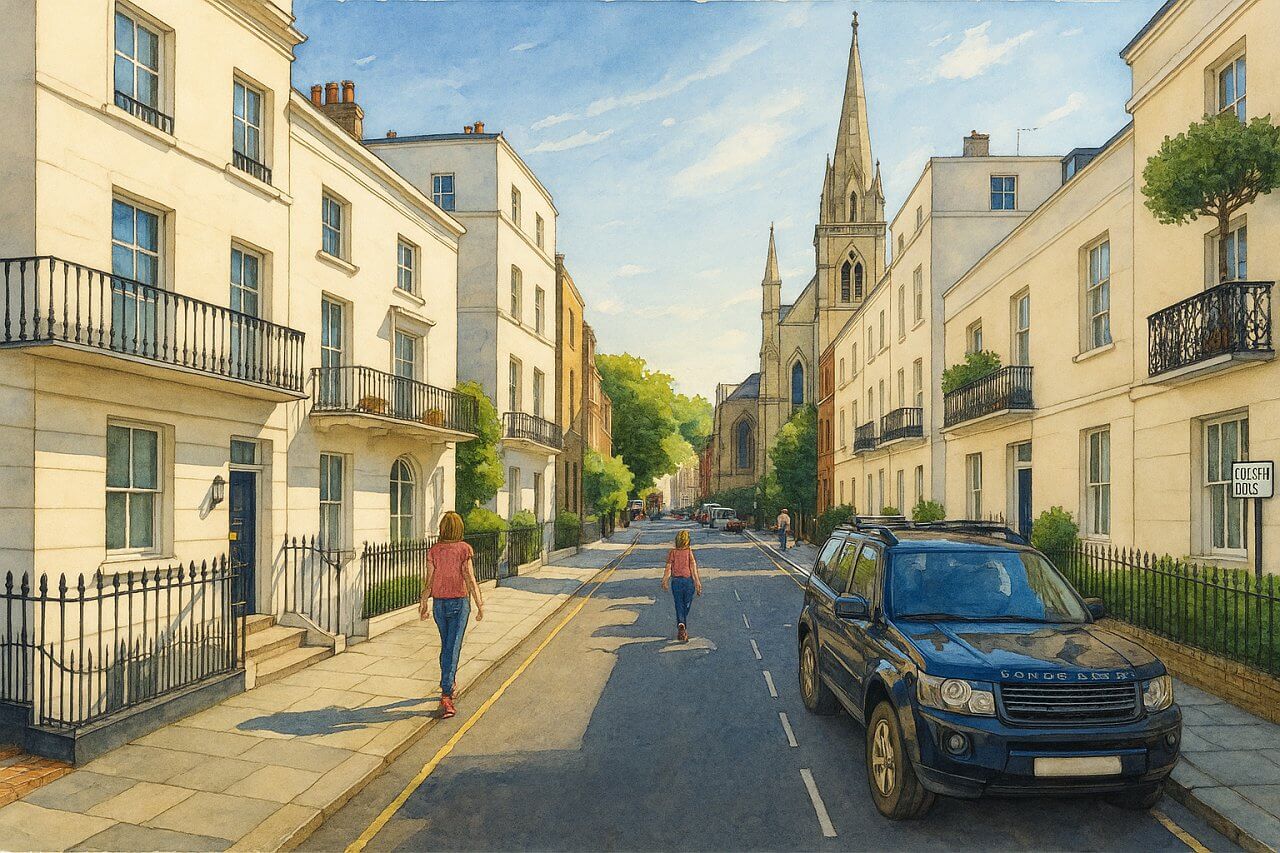
Chester Row, London
Chester Row is a charming residential street nestled in the heart of Belgravia, one of London's most prestigious and architecturally harmonious neighbourhoods. This minor but historically rich road links Chester Square and Elizabeth Street in the north to Whittaker Street and Bourne Street in the south, passing through intersections with South Eaton Place and Eaton Terrace.
Street Layout and Traffic Direction
Chester Row is approximately 300 metres in length and primarily residential in character. The southern portion of the street—from Eaton Terrace to Bourne Street—is one-way, with traffic permitted to flow only in a southbound direction. The rest of the road is two-way, allowing vehicles to circulate more freely in this quiet and well-ordered corner of Belgravia.
History and Origins
Chester Row was laid out during the first half of the 19th century, part of the large-scale development of Belgravia by the Grosvenor Estate, headed by the Duke of Westminster. The area was transformed from open fields and marshland into a sophisticated residential district filled with grand terraces and leafy squares.
The street takes its name from Chester, a nod to the Earl Grosvenor’s ancestral connection to the city of Chester in Cheshire. The pronunciation of "Chester" is /'tʃɛstə/  , or "CHESS-tuh" in simple phonetics. Naming streets after family titles and regions linked to the aristocracy was a common practice at the time, reinforcing the sense of heritage and prestige that still defines Belgravia today.
, or "CHESS-tuh" in simple phonetics. Naming streets after family titles and regions linked to the aristocracy was a common practice at the time, reinforcing the sense of heritage and prestige that still defines Belgravia today.
Character and Atmosphere
Chester Row has retained a distinctly Georgian and early Victorian character, with most buildings constructed in classic stucco-fronted or yellow brick terrace styles. The façades are typically three to four storeys high, with elegant sash windows and modest front gardens. The street has an understated charm, offering tranquillity in close proximity to some of London's most desirable amenities.
The neighbourhood is home to professionals, diplomats, and international families, and the properties are often either fully restored period homes or high-specification flats within converted buildings.
Notable Sights and Attractions Nearby
While Chester Row itself is a quiet residential street, its surroundings are rich in notable landmarks and local charm:
- Chester Square – A private garden square with elegant residences and mature trees, just steps away from the north end of the street.
- St Michael’s Church, Chester Square – A neo-Gothic parish church with notable musical and social events.
- Elizabeth Street – A boutique-lined thoroughfare filled with independent shops, florists, and cafés including Peggy Porschen Cakes.
- Pimlico Road – A design district offering art galleries, antique shops, and interior showrooms.
Property and Real Estate
As of early 2025, property prices on Chester Row reflect Belgravia’s elite status. A typical freehold townhouse with approximately 2,000 to 2,500 square feet (186–232 sq m) of living space sells for between £5.5 million and £7.5 million, depending on renovation level and exact location. Flats carved out of period houses are also available, often ranging from £1.5 million to £3 million for 1- to 2-bedroom units with around 800–1,200 square feet (74–111 sq m) of space.
This positions Chester Row among the most expensive residential streets in London, rivalling other elite postcodes such as Kensington, Mayfair, and Knightsbridge.
Public Transport and Accessibility
Nearest Underground Stations
- Sloane Square (District and Circle lines) – Around a 7-minute walk to the north.
- Victoria Station (Victoria, District, and Circle lines) – Roughly a 10-minute walk, also offering National Rail and Gatwick Express services.
Bus Services
The nearest bus stops can be found along Elizabeth Street and Ebury Street, with services including:
- Bus 11 – Running between Fulham Broadway and Liverpool Street.
- Bus 24 – Connecting Pimlico to Hampstead Heath via Westminster and Camden.
- Bus 211 – From Hammersmith to Waterloo via Chelsea and Victoria.
Fun Fact
Chester Row was once home to journalist and author Malcolm Muggeridge, a leading figure in mid-20th century British media. He lived here during his tenure as editor of Punch magazine and hosted many literary guests at his Belgravia home.
Quick Facts
- Location: Belgravia, City of Westminster, London
- Length: Approximately 300 metres
- Traffic: One-way southbound between Eaton Terrace and Bourne Street
- Built: Early 19th century, as part of Grosvenor Estate’s Belgravia development
- Name origin: Named after the Grosvenor family’s connection to Chester; pronounced “CHESS-tuh” (/ˈtʃɛstə/)
- Architectural character: Georgian and Victorian terraces
- Nearby sights: Chester Square, Elizabeth Street, St Michael’s Church, Pimlico Road
- Property prices (2025): £5.5–£7.5 million for townhouses; £1.5–£3 million for flats
- Nearest tube stations: Sloane Square (District, Circle); Victoria (Victoria, District, Circle)
- Bus connections: Routes 11, 24, and 211 from nearby streets
- Fun fact: Malcolm Muggeridge, famed British journalist, lived on Chester Row
Map of Chester Row, London

Painting of Chester Row, London (View image in full size)